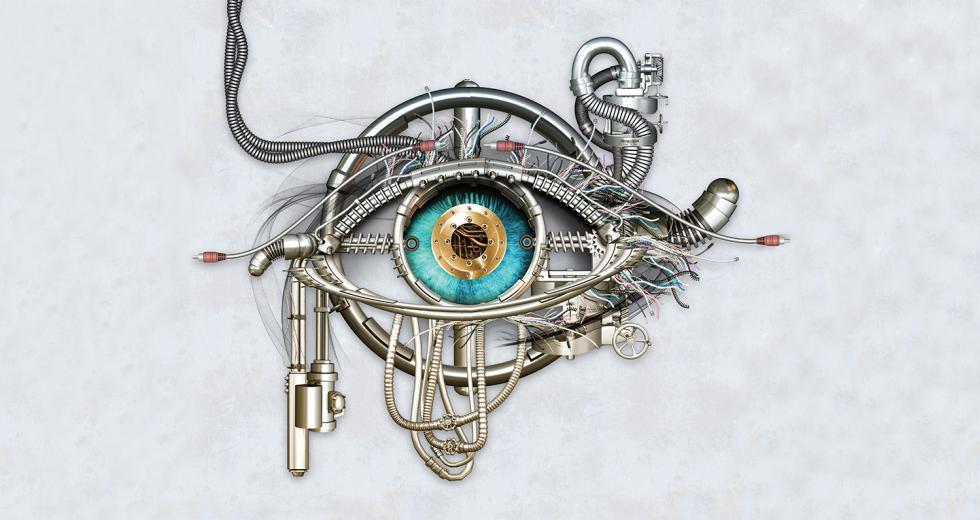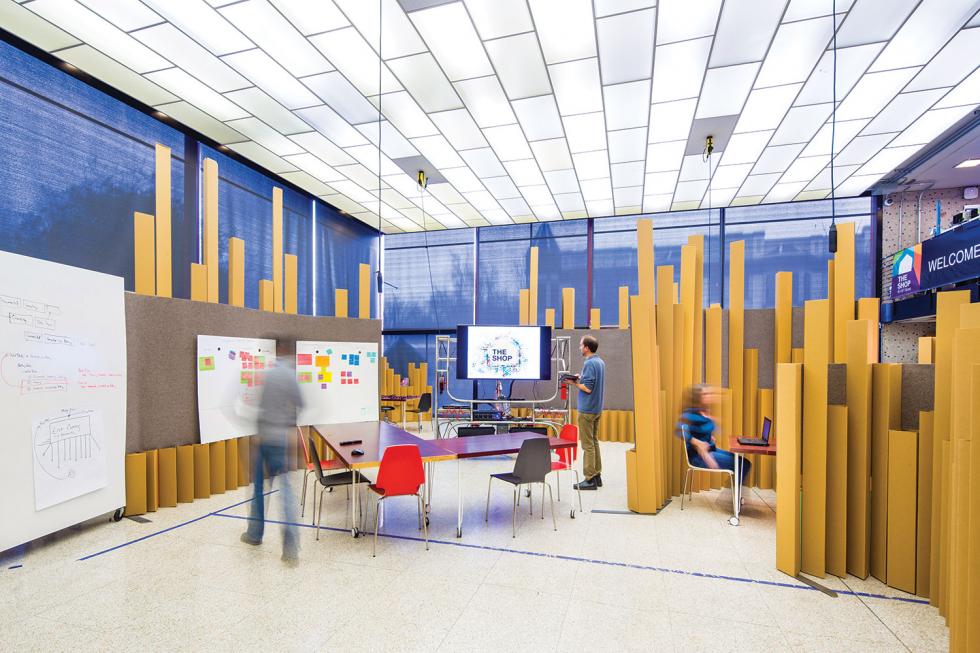Jay Sales is wearing black-framed glasses. They look good: normal, stylish. He takes them off and shows them to me, opening a tiny door in the frame that reveals a compartment of electronic gizmos. “Glasses like these could one day add five years to your life,” he says.
Sales is an executive at VSP, or Vision Service Plan. It’s the kind of company that flies beneath the radar. Even though it has been around since 1955, many people only know it from the fine print of their health care plans — for a few extra bucks a month, you can add VSP to your insurance package to cover glasses and contacts. Yet this adds up. With a roster of 77 million customers, VSP covers more people than any other provider in the U.S. And through their new think-tank, The Shop, VSP is on a mission to revolutionize the very nature of glasses, transform the way we collect health data and, as Sales predicts, add five years to our lives.
“In order for a company like VSP to be around for 60 years, we’ve had to be innovative — to change who we are,” says incoming CEO Jim McGrann, who used to be the company’s Chief Technology Officer. Plenty of companies like to toss around buzzwords like “innovation,” but it’s usually just an empty slogan. VSP has spurred innovation by creating The Shop, launching their Project Genesis, and supporting a 90-day rotational program that lets everyday employees — no matter what division they work in — pitch new ideas and brainstorm new products. Right now this is all behind the scenes. Soon it could be very, very public.
The Shop
At a 2012 corporate retreat in Napa, VSP executives listened as Andrew Hargadon, a professor of technology management at UC Davis, gave a speech on the difference between invention and innovation. “Innovation is about taking the inventions that are out there and figuring out how to bring them together,” McGrann says. The VSP team realized that they could do this. The company was already at the crossroads of health (with a network of 34,000 optometrists), fashion (collaborating with brands like Diane Von Furstenberg, Nike and Ferragamo) and tech (having partnered with Google Glass on frames). What they needed was a place to connect all the dots and so, McGrann says, “We decided that we’re going to open up our own innovation lab.”
The Shop in Sacramento, headed by Sales and located on 17th and I streets in midtown, opened in December 2012. At the same time, they opened a New York wing of The Shop, located just steps from Bryant Park, headed up by Leslie Muller. A third is opening up in Columbus, Ohio. Both locations offer a jumble of tech, fashion, design, optometry and health, so it’s no surprise that Sales has a background in technology, Muller in fashion.
During the week of the company’s 60th anniversary, I meet Muller and Sales at the New York shop, which has a vibe that’s airy, open and bright — like an Apple store crossed with an optometrist’s office. Designers sit next to engineers. Spontaneous meetings happen in the hallways. “There’s a lot of cross-pollination,” says Muller as she gives me a tour. “It’s frictionless.” A team of fashionably dressed 20- and 30-somethings sit huddled together with prototypes of glasses arranged neatly on counters.
“The goal is to ‘fail fast,’” says Muller, explaining that everyone is encouraged to whip up ideas, quickly try them and if something fails, repeat the process. When you have a bloated corporate bureaucracy, it can take months or even years for a bad idea to be recognized as such. The Shop hastens the turn-around time. A designer can conjure up an idea, spec it out, then zap it to an onsite 3D printer, which spits out a prototype that very night. The production cycle has shrunk from months to days.
As we walked by one pair of glasses, Muller stopped to look at it more closely.
“Look at this,” she says, smiling. “The 3D printer had a glitch.”
For some reason the printer didn’t print the top rim of the glasses, giving it a funky, futuristic look. A few employees come closer and stare at it, curious.
“Hmmmm,” she says, intrigued by the quirk. “Maybe there’s something here.”
It wasn’t quite an apple falling on Newton’s head, but you get the feeling that things like this happen a lot at The Shop.
Project Genesis
The Shop’s flagship product is a set of frames called Project Genesis, the ones that Sales predicts could eventually add five years to people’s lives. These aren’t like Google Glass: There’s no magic computer monitor, twitter updates or Terminator-style optical display. The concept is simple, similar to that of the Fitbit but in a pair of glasses. This has three advantages over wristbands. The first is that people simply get tired of wearing those little plastic bracelets. I wore my Fitbit for a month, loved it but soon got bored. When I lost it in a cab, I never replaced it.
“That’s exactly the problem we’re trying to solve!” says Sales in response. “People use it for a while and then they lose it, or they forget about it.” Glasses are different. You put them on before getting out of bed; you take them off just before sleep. “Glasses are history’s first wearable technology,” says Muller. No training is necessary.
The second advantage: aesthetics. “When people wear the wristbands, you don’t really have any choice but to wear what everyone else is wearing,” Muller says. “Maybe it can be pink or green, but there’s no individual expression.” Thanks to its fashion chops, VSP can provide that choice.
The potential game-changer, though, has to do with the tracking accuracy and the basic laws of physics. “With Genesis, the accelerometer is aligned with the middle of your head,” says Sales, touching the top of his nose. “That’s much more accurate than when you’re swinging your wrist.” The consequences are sprawling. With hyper-accurate data, it’s possible to analyze the pattern of someone’s gait and use that to avoid a hip injury. In physical therapy, the doctor can study the data to see if the patient is on track to recovery. In the world of sports, a coach could use the data to evaluate performance.
“The goal is for this to be frictionless,” says Muller, “so it fits in your normal routine.”
The glasses collect data, and the data could be powerful. “In the future, when you go to the doctor’s office, instead of saying, ‘Do you take my insurance,’ you might say, ‘Do you take my data?’” says Sales. Through partnerships like the one VSP has with the University of Southern California’s Center for Body Computing, they’re exploring how this data could contextualize health and give better care. “This data can help doctors detect diabetes, hypertension and high cholesterol. It can actually help lives.”
The Rotation Program
It’s useful to get the opinion of an outsider. They can look at things with fresh eyes and say, “Why do you do it like this?” VSP has tapped into something very basic that’s easy for companies to overlook: Outsiders exist within a company. A clerk in the accounting department is an outsider to the designers; an engineer is an outsider to insurance actuaries. This can be exploited. VSP has created a 90-day rotational program where employees actually leave their normal jobs for three months — they change desks, change coworkers, sometimes change cities — to join The Shop where they brainstorm ideas, challenge the status quo and even dream up new products. It’s an innovation bootcamp.
“The Shop is about empowering you to let go of corporate culture and embrace the spirit and attitude of innovation,” says Tim Wickham, who went through the inaugural bootcamp. A former optician, Wickham worked for VSP as a product manager for their practice management software company. “There’s no business attire and definitely no email,” he says of the environment. “If you need to grab someone to discuss an idea, do it. If you need space to draw out your idea, do it. Want to build your idea with Legos? Do it.” Even the physical space is different: no corner offices and no closed cubicles. “It’s set up like small garages with tables, chairs, whiteboards, and shelves for stuff. We would hear each others’ conversations, jokes and frustrations.”
Okay, this sounds great and all, but it’s fair to ask: Does this free-wheeling atmosphere, you know, actually do anything? Enter the iBeacon. You might have already seen this technology in certain grocery stores. The iBeacon is a little gadget that emits a low-energy Bluetooth pulse, and when your smartphone gets close to it, the beacon sends you a customized message. So when you’re standing in the toothpaste aisle, for example, the iBeacon can send you a coupon for Crest. At The Shop, Wickham’s team was charged with finding a way to somehow make iBeacon useful for VSP. So they dug into what customers enjoy, and don’t enjoy, about buying glasses.
They soon found a problem that needed to be solved. When you walk into a store that sells glasses, the sheer number of options can be overwhelming — hundreds of different prices, shapes and styles. (Psychologists call it the Paradox of Choice: When we have too much, it’s harder to choose.) But what if the iBeacon could help narrow things down? Wickham’s team’s idea envisions a customer on a smartphone able to select the brands, prices and shapes of glasses they’d be willing to consider. Then, the second that customer walks into the store, the iBeacon would detect those preferences and only the glasses that fit the criteria would be lit up on the wall. Now you just see 17 pairs of glasses. They call it the Interactive Frameboard. The concept has gone from a wacky idea to an operational prototype; a beta version is up and running in the Sacramento showroom.
But the true value of the rotation program, according to McGrann, is what happens after employees like Wickham go back to their normal jobs. “You can’t put a price tag on the value of this,” he says. The bootcamp alumni become innovation evangelists.
“Everything I do back on campus, I’m looking for ways to encourage, empower and challenge folks to think outside the box,” says Wickham. It’s also true that this chaos isn’t for everyone. “When we did the first session, 90 percent of [people] went through with flying colors,” says McGrann. “But there were a couple of people who learned, ‘I kind of like a certain structure, and The Shop isn’t necessarily for me.’ And that’s OK, too. You’re not going to have 6,000 Jays and Leslies in the company.”
Project Genesis might or might not revolutionize glasses, and it might or might not add five years to our lives. Time will tell. But it does seem clear that if you want to truly embrace a concept like innovation, you need to do more than just print out a poster and stick it on the wall. The good news is that it’s possible. The better news is that you don’t have to be a tech darling from Silicon Valley; innovation can come from anywhere — even 60-year-old insurance companies.





Comments
very forward thinking company!
The Shop Rotation Program is incredible. I was a member of one of the Round 2 teams and it was unlike any experience I've ever had before (except spending a year abroad in China when I was 17). Innovation is truly alive at our company, and I couldn't be more honored to be part of this next chapter in our company's history.